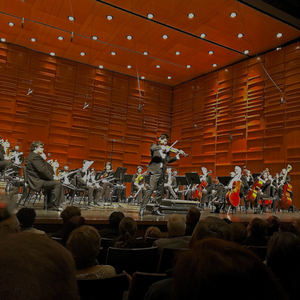Review: CSO and Graf Make Debussy's FAUN a Dynamic Prelude

Slipping out of town for Charlotte Symphony's Firebird concert back in October, maestro Christopher Warren-Green has orchestrated a nice little three-month vacation for himself, but so far, the music director's pinch-hitters on the podium haven't let him or us down. Christopher James Lees was best when he lit into the Stravinsky that subscribers came for, and last week in his Queen City debut, German-born guest conductor Hans Graf demonstrated his mastery at Knight Theater on works by Brahms, Mozart, and the evening's headliner, Debussy's Prelude to the AFTERNOON OF A FAUN.
The CSO rarely leads off their programs with their marquee piece, but L'Après-midi was the shortest on the bill, so its position wasn't shocking. The last time the piece was played as part of a Classics Series in 2003, the beloved tone poem actually launched Symphony's season after musicians went on strike over pay cuts. Since that momentous "French Masters" program conducted by Christof Perick at Belk Theater, Warren-Green has presented L'Après-midi at UNC Charlotte in a most unusual concert - scientifically proving that, after an Allegro from Tchaikovsky's "Pathétique" Symphony, a little Debussy will bring your blood pressure back down.
A medicinal effect wasn't Graf's aim at all, scorning the notion that L'Après-midi is all about casting a misty, hypnotic spell. There were actually pauses in the performance, like you'll hear in recorded accounts conducted by Herbert von Karajan and Bernard Haitink. You could actually imagine Debussy conceiving his interpretation of Stéphane Mallarmé's symbolist poem as a series of scenes and reveries. When the orchestra swelled, the dynamic range was as robust as Simon Rattle's recording with the Berlin Philharmonic, reminding me how unaccustomed I was to sitting so close to the ensemble at Knight Theater. Yet the woodwinds blended piquantly where they should, and principal flutist Victor Wang exquisitely led us into the enchanted glade.
Returning for a second stint with Symphony after playing Bruch No. 1 in the spring of 2016, Chinese-born Angelo Xiang Yu gave a showy, ebullient account of Mozart's "Turkish" Violin Concerto No. 5, sparking outbursts of audience applause after the opening Allegro aperto movement and after the less-familiar middle Adagio. Yu forcefully produced a gleaming, golden tone from his 290-year-old Stradivarius and seemed to be having fun even in the slow movement. Like Graf, Yu relished changing tempos and dynamics, approaches that yield happier results with Mozart than with Debussy's concupiscent Faun. A little puckish mischief was mixed with the fun during the final Rondeau, making the joy even more contagious. More gusto from the lower strings during the "Turkish" section of the finale would have added some agreeable lagniappe.
Yu never did hide his delight in performing, so it wasn't surprising that he could be coaxed into an encore. Yu probably wasn't punning when he said he had first heard his little Piazzolla tango on YouTube a couple of days earlier - and still hadn't been able to acquire the sheet music. Maybe it's in the mail, since it sounded to me like the Tango Etude No. 3 that I was able to find on Spotify in a couple of versions.
Likely judging that audiences will always enjoy Brahms Symphony No. 2, especially its concluding Allegro con spirito, CSO has now programmed it three times during the last six years. Outside the Classics Series rotation, that final movement last popped up at a 2015 Bachtoberfest at the Knight. Until we reached that rousing spirito at the full 2014 performance, Warren-Green and the orchestra had sounded rather spiritless. Continuing to emphasize dynamic contrasts, yet still vigilant with detail, Graf drew more excitement from his musicians and more energy from Brahms.
The opening Allegro non troppo was especially freshened with sharper shaping, eloquent violins, and a new hint of sadness from the cellos. Yet Graf kept his finger more persistently on the slower middle movements, where languor has won out in the past. The Allegro con spirito now hearkened back to the opening of the Mozart, where Symphony and Yu initially lulled us with a deceptive sense of calm. On both occasions, Graf had the orchestra exploding brilliantly, and with trumpets blaring and principal timpanist Ariel Zaviezo unleashed, the evening ended giddily, like a triumphant military march just slightly out of control.
Reader Reviews

Videos
